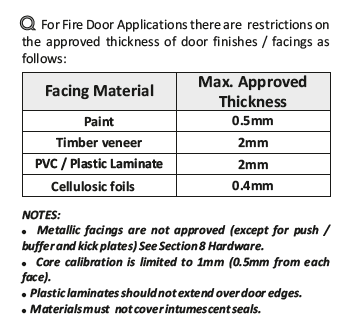-
Posts
505 -
Joined
-
Last visited
Everything posted by Neil Ashdown MAFDI
-

Upgrading lazing beads to wired glass panel
Neil Ashdown MAFDI replied to a topic in Fire Doors and Accessories
Its a question for the 'inspector' but if you can demonstrate that you have carried out the works in accordance with the wired glass manufacturer's requirements, that should be acceptable. https://mbp.co.uk/wp-content/uploads/2021/05/PYROGUARD-CF5954-Pyrostem-exp.20260524-rev.20210525.pdf https://www.pilkington.com/en-gb/uk/products/product-categories/fire-protection/pilkington-pyroshield-2 Above are only suggestions as we don't know which product the wired glass is and when it was made. Where you are unable to identify the glass, you should use best practice methods https://shop.ggfmembers.com/a-guide-to-best-practice-in-the-specification-and-use-of-fire-resistant-glazed-systems-ref-20-1/ and https://www.ggf.org.uk/about-the-ggf/contact/ -
Yep. In this context, better to lip the bottom rather than the top.
-
Always difficult with non-intrusive inspection and when there's no evidence. In terms of guidance https://www.local.gov.uk/sites/default/files/documents/Fire Door FAQs.pdf
-
For certainty on this matter, always contact the door leaf / door blank manufacturer for advice. There isn't much in the way of information on-line on this particular subject but this is quite helpful: https://www.falcon-timber.com/downloads/ Typically guidance on applying facings might look something like this:
-
Q2). A couple of doors have maglocks that have been bolted through the door. There is no information on the door. The inspector recommends new doors as there is an integrity breach. Can maglocks be removed & door repaired? ( 2- I'll let the forum's fire door specialist address this next time he logs on ) : A) There are some timber-based fire door / magnetic lock combinations that do have evidence of fire resistance performance. So, it may not be appropriate for the mag-locks to be removed / fire doors replaced - it would depend on the type of door leaf construction and the type of mag-lock. I would advise that first a risk assessment should be carried out to evaluate the risk to life safety and building safety were the fire doors to fail to provide their ultimate fire resistance performance as designed. Where the risk is untenable and a certificated solution is required then the fire doors should be replaced with a set that are suitable for mag-locks. If the mag-locks are no longer required and it is felt that the doors do not require certification and can be repaired - then the repairs to the door leaves and frame should be made to a joinery standard using suitable hardwood tightly fitted with no holes, gaps or voids.
-

Concealed Closers Height
Neil Ashdown MAFDI replied to Gorley81's topic in Fire Doors and Accessories
Begin with the self-closer manufacturer, the may be able to put you in contact with a door manufacturer that has dual certification using their self-closer. -
Yes, as you have picked up - the lipping must be flush with the face of the door. So lipping may be replaced or added to the edges of the door but the hardwood must be of the correct dimensions, species, density and fitted with the correct adhesive. This type of 'repair' is very likely to fall outside the scope of the fire resistance performance certification for the door and therefore the certification would become invalid.
-

Hinge blade positions and intumescent strips
Neil Ashdown MAFDI replied to Tom1234's topic in Fire Doors and Accessories
Before you fill that gap with intumescent or non-combustible material check that: The fire door leaf does not sit proud of the door frame at any point. Have the hinges been checked for compatibility with the fire door leaf, in terms of fire rating and dimensions? Are these 'extended butts', are the fire doors intended to open to 180 deg? -

Flat entrance fire doors.
Neil Ashdown MAFDI replied to Gedandsue's topic in Fire Doors and Accessories
https://www.safelincs.co.uk/fire-door-installation/ -
As Nick T says above, the thickness of the hardwood lipping would very likely be outside the scope of the door's Assessment report for fire resistance were they carrying any evidence of performance. You state that the door is a Nominal fire door which means in the opinion of the 'competent person' that the door has the attributes of a fire door but that there is no evidence of fire resistance performance. Therefore, whilst it is likely that the door could be non-compliant to its original manufacturer's 'certification' there is no documentary evidence to confirm this in absolute terms. I would advise the Responsible Person to risk assess in terms of how critical are the fire doors to life safety and building safety should they fail to provide their ultimate required fire resistance performance. Also, the gap between the door top edge and the underside of the door frame head appears to be excessive. Generally, it should be between 2mm and 4mm so there could be an issue with cold smoke spread as well as fire resistance performance. Also, the door-closer arm configuration is incorrect. The adjustable arm should be at 90 deg. to the door frame head with the tensioning-arm canted over accordingly. Remediating this will very likely improve the door-closer performance.
-
These signs are designed so that the lollipop shaped blue coloured sign is conspicuous when the door is open. Eg: when there is potential for danger. Consult the document: Code of practice. Hardware for fire & escape doors, section 10 deals with signs, at http://firecode.org.uk/Code_of_Practice_hardware_for_fire_and_escape_doors.pdf
-

Sealant between the fire-door and the opening
Neil Ashdown MAFDI replied to Kennedy123's topic in Fire Doors and Accessories
Consult the 1990 version of the standard BS 8214 Timber-based fire door assemblies - Code of practice. https://knowledge.bsigroup.com/products/code-of-practice-for-fire-door-assemblies-with-non-metallic-leaves/standard -
Looks like a composite construction flat entrance door and looks similar to one I have seen before by Manse Masterdoor. What makes you believe the core is solid timber?
-

double swing hinges on a fire door
Neil Ashdown MAFDI replied to a topic in Fire Doors and Accessories
Best solution is to fit floor springs and pivots. See page 39 of the document Hardware for Fire & Escape Doors - Code of practice http://firecode.org.uk/Code_of_Practice_hardware_for_fire_and_escape_doors.pdf -

Flat fire door for private entrance
Neil Ashdown MAFDI replied to Nibarb's topic in Fire Doors and Accessories
That's useful to know, Anthony. Do you have link (and page/section number) to the gov guidance document? -
From what you say it seems clear that area of the house could be at risk from the effects of a fire in the garage. I would consult the housing department at your local authority on this matter.
-

Flat fire door for private entrance
Neil Ashdown MAFDI replied to Nibarb's topic in Fire Doors and Accessories
Yes the entrance door to your flat should be fire resisting and with restricted cold smoke spread. -

Fire doors in a domestic 3 storey house
Neil Ashdown MAFDI replied to a topic in Fire Doors and Accessories
This web page may be of use https://www.safelincs.co.uk/dorgard-and-other-fire-door-retainers/?fga=true&gclid=Cj0KCQjwpPHoBRC3ARIsALfx-_KyYyOV-N89A62lUXg5rqol-n7fyaLCx-wcVIx2tZaAZIVSKZrvQqsaArbQEALw_wcB -

Adding vision panel to fire door
Neil Ashdown MAFDI replied to a topic in Fire Doors and Accessories
I have inspected many fire doors to stair and lift lobbies at blocks of flats. Some older blocks have doors without vision panels but clearly a door in such a location is safer for the user when there's a vision panel.- 25 replies
-
- fire door
- vision panel
-
(and 1 more)
Tagged with:
-

Does ventilation grille damage fire door?
Neil Ashdown MAFDI replied to a topic in Fire Doors and Accessories
The main issue is that a standard intumescent air transfer grille will not restrict the spread of cold smoke. Also, installation of such a device should be done by a competent person so as to ensure the door's fire integrity performance is not compromised. If the door in question opens on to an escape route, there is a risk that cold smoke from inside (in a fire event) may impede persons attempting to use the escape route. Your fire risk assessment should note this and recommend action accordingly.- 20 replies
-
- fire door
- ventilation grille
-
(and 2 more)
Tagged with:
-
In my view, the mirror is rather large and heavy. I would not recommend fitting such a mirror to a fire door due to risk of causing twist to the timber door leaf. Much better on the wall or maybe a wardrobe, if possible.
-
What size are the screws? Where on the door are you fitting the mirror (will it be near the door edges) and how big and how heavy is it? What have the block owners/mangers said about this?
-
My understanding is that the doors are FD30s fire resisting doors. Are the rack bolts compliant with paragraphs 6.2.2 and 6.2.3 on page 61 of the document 'Hardware for Fire & Escape Doors' ?


